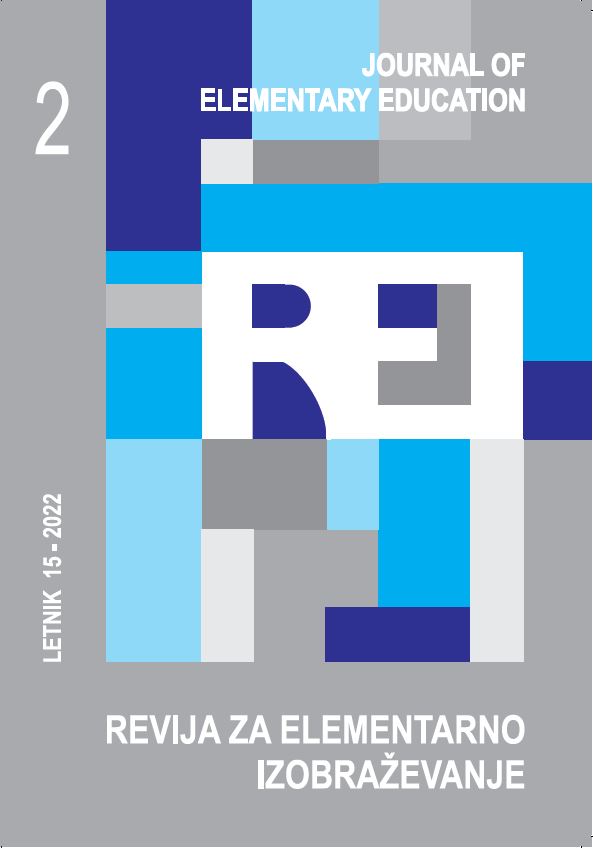Are Pedagogical Students More Creative than Students of Non-Pedagogical Programs?
DOI:
https://doi.org/10.18690/rei.15.2.199-210.2022Keywords:
creativity, gender, pedagogical and non-pedagogical orientation of study, university studentsAbstract
The study aims to explore whether there are significant differences in self-assessed creativity between pedagogical and non-pedagogical students, the potential connection between creativity and pedagogical or non-pedagogical study orientation, whether the pedagogical or non-pedagogical orientation of studies influences creativity, and additionally whether there are significant differences in self-assessed creativity between the genders, related to the results of creativity self-assessment. The results showed no statistically significant differences in creativity between students according to gender or according to whether they were pedagogical or non-pedagogical students. We can conclude that the expression of creativity is likely to be influenced by many other factors.
Downloads
References
Al-Ababneh, M. M. (2020). The Concept of Creativity: Definitions and Theories. International Journal of Tourism & Hotel Business Management, 2(1), 245–249. Retrieved from https://www.scitcen–tral.com/arti–cle.php?journal=46&article=-998&article_title=THE%2–0CONCEPT%20-OF%20CREATIVITY:%20DEFINITIONS%20AND%20THEORIES#tabs6 (Accessed: 12. 08. 2020)
Baer, J., and Kaufman, J. C. (2008). Gender Differences in Creativity. The Journal of Creative Behavior, 42(2), 75–105. https://doi.org/10.1002/j.2162-6057.2008.tb01289.x
Barbot, B., Besançon, M., and Lubart, T. (2011). Assessing Creativity in the Classroom. The Open Education Journal, 4(2), 58–66. Retrieved from https://benthamopen.com/conten–ts/pdf/TOEDUJ/TOEDUJ-4-58.pdf (Accessed: 20. 05. 2022)
Cohen, B. (2008). Explaining Psychological Statistics (3rd ed.). John Wiley & Sons.
Cheung, C.-K., Rudowicz, E., Yue, X., and Kwan, A. (2002). Creativity of university students: What is the impact of field and year of study? College Student Journal, 37(1), 42–63. https://doi.org/–10.1002/j.2162-6057.2003.tb00825.x
Council Conclusions on a Strategic Framework for European Cooperation in Education and Training (‘ET 2020’) (2009). Retrieved from https://eur-lex.europa.eu/legal-content/EN/TXT/?u–ri=celex:52009XG0528(01) (Accessed: 13. 05. 2020)
Guilford, J. (1950). Creativity. American Psychologist, 5(9), 444–454. https://doi.org/10.1037/h0063487
Hartley, J., and A. Greggs, M. (1997). Divergent thinking in arts and science students: Contrary imaginations at Keele revisited. Studies in Higher Education, 22(1), 93–97. Retrieved from https://doi.org/10.1080/03075079712331381161(Accessed: 20. 05. 2020)
Hoffmann, J., Ivcevic, Z., and Brackett, M. (2016). Creativity in the Age of Technology: Measuring the Digital Creativity of Millennials. Creativity Research Journal, 28(2), 149–153. https://doi.org–/10.1080/10400419.2016.1162515
Jaušovec, N. (1987). Spodbujanje otrokove ustvarjalnosti. [=Eng: Encouraging children's creativity]. Državna založba Slovenije.
Kumar, V. K., Holman, E. R., and Kemmler, D. (1997). The Creativity Styles Questionnaire-Revised. Creativity Research Journal, 10(1), 51–58. https://doi.org/10.1207/s15326934crj1001_6
Merckelbach, H., Horselenberg, R., and Muris, P. (2001). The Creative Experiences Questionnaire (CEQ): a brief self-report measure of fantasy proneness. Personality and Individual Differences, 31(6), 987–995. https://doi.org/10.1016/S0191-8869(00)00201-4
Oliver, M., Shah, B., McGoldrick, C. and Edwards, M. (2006). Students’ experiences of creativity. In Jackson N. J., Oliver, M., Shaw, M. and Wisdom, J. (Eds.), Developing Creativity in Higher Education: An imaginative curriculum, (1st ed., pp. 43- 58). Routledge.
Ozkan, G., and Topsakal, U. (2019). Exploring the effectiveness of STEAM design processes on middle school students’ creativity. International Journal of Technology and Design Education, 31(4) https://doi.org/10.1007/s10798-019-09547-z
Pilar Matud, M., Rodríguez, C., and Grande, J. (2007). Gender differences in creative thinking. Personality and Individual Differences, 43(5), 1137–1147. https://doi.org/10.1016/j.paid.2–007.03.006
Recommendation of the European Parliament and of the Council on Key Competences for Lifelong Learning (2006). Retrieved from https://eur-lex.europa.eu/legal-content/EN/TXT/?uri=–celex:32006H09-62 (Accessed: 12. 08. 2020)
Runcoa, M., Acarb, S., and Cayirdaga, N. (2017). A closer look at the creativity gap and why students are less creative at school than outside of school. Thinking Skills and Creativity, 24, 242–249. https://doi.org/10.1016/j.tsc.2017.04.003
Sternberg, R. J. (2006). The nature of creativity. Creativity Research Journal, 18(1), 87–98. http://dx.doi.org/10.1207/s15326934crj1801_10
Šorgo, A., Lamanauskas, V., Šimić Šašić, S., Kubiatko, K., Prokop, P., Fančovičova, J., Bilek, M., Tomažič, I., Erdogan, M. (2012). A cross-national study of prospective elementary and science teachers’ creativity styles. Journal of Baltic Science Education, 11(3), 285–292. Retrieved from http://oaji.net/articles/2014/987-1419168605.pdf (Accessed: 10. 08. 2020)
Torrance, E. P. (1972). Predictive validity of the Torrance test of creative thinking. Journal of Creative Behavior, 6(4), 236–252. https://doi.org/10.1002/j.2162-6057.1972.tb00936.x
Torrance, E. P. (1965). Rewarding Creative Behavior: Experiments in Classroom Creativity. Prentice-Hall.
Treffinger, D. (1995). Creativity, Creative thinking, and Critical Thinking: In search of definitions. Center for Creative Learning.
Van Goch, M. (2018). Creativity in liberal education before and after study commencement. In Domenech, J., Merello, P., de la Poza, E., Blazquez, D., Peña-Ortiz, R. (Eds.) 4th International Conference on Higher Education Advances (HEAd’18), 1475-1483. Universitat Politécnica de Valéncia.
Zare, B. (2011). Creativity Differences between Art and Engineering Students. International Conference on E-business, Management and Economics, 25, 207–211.
Downloads
Published
Issue
Section
License
Copyright (c) 2022 Dejan Zemljak, Mateja Ploj Virtič

This work is licensed under a Creative Commons Attribution 4.0 International License.
